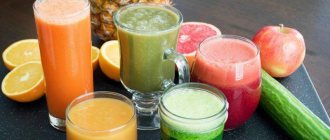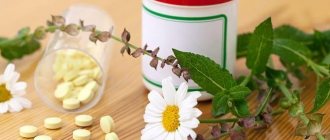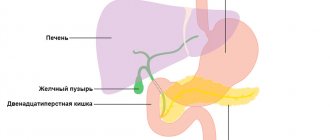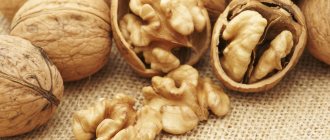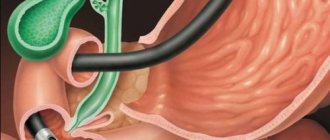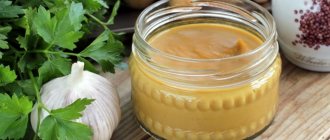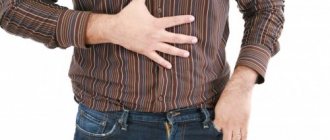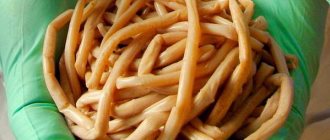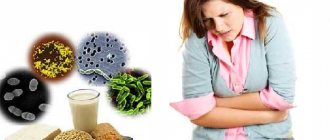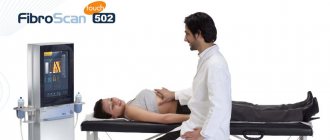Cholecystitis, an inflammation of the gallbladder, requires long-term treatment in combination with diet. Often the disease takes a chronic form and manifests itself with exacerbations.
Pain in the right side, heartburn, a feeling of a lump in the throat and a burning sensation on the tongue cause persistent discomfort. With advanced cholecystitis, stones appear in the gall bladder. Excess hydrochloric acid in the stomach leads to gastritis and reflux esophagitis - a disease of the esophagus. Intestinal motility worsens. The temperature is rising. Neglecting treatment can lead to surgery or death.
Classification of cholecystitis
According to the course, cholecystitis can be acute and chronic.
Depending on the reasons that caused the development of the disease, the following types of cholecystitis are distinguished:
- calculous – the formation of stones is observed in the gallbladder, occurs in 80% of cases;
- stoneless - occurs in approximately 20% of cases.
Acalculous cholecystitis usually occurs in young patients. In people over 30 years of age, the vast majority of cases are diagnosed with calculous cholecystitis.
Causes of cholecystitis
The main reasons for the development of the disease are:
- gallstones;
- pathological outflow of pancreatic enzymes into the gallbladder;
- infections (salmonella, streptococci, staphylococci and a number of others);
- congenital deformity of the gallbladder;
- parasites (cat fluke, dysenteric amoeba, helminths);
- tumors of the abdominal organs;
- decreased acidity of gastric juice;
- biliary dyskinesia;
- mechanical injuries and damage to the gallbladder;
- diseases associated with metabolic disorders in the body (diabetes mellitus, atherosclerosis);
- obesity;
- allergies;
- excessive physical activity or, conversely, a sedentary lifestyle;
- poor nutrition, abuse of fast food and other unhealthy foods;
- pregnancy;
- sudden shaking of the body (when running, cycling, etc.);
- mental stress, stress, depression;
- hypothermia;
- age-related changes in the gallbladder;
- frequent constipation.
Acute calculous cholecystitis
Acute calculous cholecystitis is an acute inflammation of the gallbladder containing stones. Prevalence. Acute calculous cholecystitis ranks second in frequency among acute surgical diseases of the abdominal organs. In 12-24% of cases it is complicated by choledocholithiasis, in 26-49% by obstructive jaundice, in 23-47% by cholangitis.
In the development of acute calculous cholecystitis, the leading role is played by the penetration of infection into the gallbladder and disruption of the outflow of bile. Microbial flora (intestinal, Pseudomonas aeruginosa, staphylococci, enterococci) enters the gallbladder ascending (from the duodenum) or descending (from the liver) by hematogenous or lymphogenous route. The outflow of bile is disrupted when stones obstruct the neck of the gallbladder or cystic duct, common bile duct, or pathological processes in the periampullary zone. The development of calculous cholecystitis is facilitated by changes in the vessels of the gallbladder wall during atherosclerosis, damage to its mucous membrane by pancreatic enzymes during pancreatobiliary reflux.
Morphologically, three types of acute calculous cholecystitis are distinguished: catarrhal, phlegmonous and gangrenous. With catarrhal cholecystitis, the gallbladder is slightly enlarged, its wall is thickened due to edema and swelling of the mucosa. The mucous membrane is cloudy due to desquamation of the epithelium and its infiltration with leukocytes. Inflammation also spreads to the submucosal layer. With phlegmonous cholecystitis, the wall of the gallbladder is significantly thickened as a result of abundant impregnation with inflammatory exudate. The mucosa is sharply hyperemic, with fibrin deposits. The bladder is much enlarged in volume, filled with purulent exudate, and covered with fibrin on the outside. In case of occlusion of the cystic duct by a stone or due to swelling of its wall, acute empyema of the gallbladder develops. With gangrenous cholecystitis, which occurs against the background of cystic artery thrombosis, partial or total necrosis of the gallbladder wall occurs. Gangrene usually occurs on the 3-4th day of the disease. Often there is perforation of the bladder wall (gangrenous-perforated cholecystitis) with the flow of bile into the abdominal cavity and the development of biliary peritonitis. Perforation occurs more often in the area of the neck of the gallbladder or Hartmann's pouch, i.e. in the places where stones are most often localized. All described pathomorphological forms of acute calculous cholecystitis are accompanied by pericholecystitis, which is characterized by a local or widespread adhesive process that limits the spread of infection to the area of the right hypochondrium.
Signs of acute calculous cholecystitis are pain in the right hypochondrium, vomiting, nausea. The pain occurs suddenly, most often after a diet violation, and radiates to the right shoulder, collarbone, lower back, and iliac region. The intensity of pain increases with the slightest physical stress. Vomiting in patients with acute calculous cholecystitis is of a reflex nature, often repeated, and does not bring relief. During an objective examination of patients, dryness of the tongue, some bloating of the abdomen and limitation of its participation in the act of breathing, severe pain and muscle tension in the right hypochondrium, especially at the point of projection of the gallbladder: the intersection of the outer edge of the right rectus abdominis muscle with the costal arch (Ker's point) are revealed. . In the absence of pronounced muscle tension in the abdominal wall in patients, an enlarged, tense, sharply painful gallbladder is often palpated (Parturier's symptom). At the same time, characteristic symptoms are determined in patients: the appearance or intensification of pain when lightly tapping the inner edge of the hand along the right costal arch (Grekov-Ortner symptom); pain on palpation in the right hypochondrium, increasing with inspiration (Keur's symptom); pain when pressing on the xiphoid process (Pekarsky's symptom); pain on palpation between the legs of the sternocleidomastoid muscle on the right above the collarbone (Mussy symptom, phrenicus symptom); the appearance or intensification of pain in the right hypochondrium when pressing with the index finger between the legs of the sternocleidomastoid muscle on the right above the collarbone (Georgievsky’s symptom); pain on palpation to the right of the navel and slightly higher in the projection of the common bile duct (Janover's symptom); pain when pressing on the right near the spinous processes of the VIII-X thoracic vertebrae (Boas symptom); irradiation of pain to the heart area (Botkin’s cholecystocardial symptom). The body temperature in patients with acute calculous cholecystitis is elevated. Neutrophilic leukocytosis and increased ESR are observed in the blood.
The severity of clinical manifestations of the disease is directly proportional to the degree of morphological changes in the gallbladder. Thus, the most rapid course is observed with gangrenous cholecystitis. However, in elderly patients, acute calculous cholecystitis occurs atypically, which is due to the lack of a clear relationship between structural changes in the gallbladder and the existing clinical manifestations. This is due to a decrease in the overall reactivity of the body and the presence of concomitant diseases. Acute calculous cholecystitis in this category of people occurs with erased local symptoms and is accompanied by rapid generalization of the main process, symptoms of intoxication, and a high incidence of complications. The body temperature of patients is usually low-grade. Tachycardia is pronounced. A discrepancy is determined between heart rate and temperature. Moderate leukocytosis with a shift to the left is detected in the blood.
The duration of acute calculous cholecystitis ranges from 3-5 days to several weeks. In most cases, the disease becomes chronic or is accompanied by complications: obstructive calculous cholecystitis - empyema or hydrocele of the gallbladder; perforation of the gallbladder (perforative, calculous cholecystitis) with the development of bile peritonitis, subhepatic and subphrenic abscesses; cholangitis; liver abscesses, etc. Complications, as a rule, accompany phlegmonous and gangrenous forms of acute calculous cholecystitis.
Empyema of the gallbladder in acute calculous cholecystitis occurs due to blockage of the cystic duct with a stone in the presence of a virulent infection in the gallbladder. Due to the progression of inflammation, pus accumulates in the lumen of the bladder. The bladder increases in size, becomes tense, and sharply painful on palpation. In the right hypochondrium, patients feel intense, constant pain that lasts for several days. The temperature rises to 38-40 °C, often taking on a hectic character with chills and frequent heavy sweating. During intensive therapy, most symptoms disappear, but patients continue to be bothered by a feeling of heaviness and pain in the projection of the gallbladder (chronic empyema). Violation of the diet and physical stress lead to an increase in body temperature to 38-39 ° C and increased pain. Hydrocele of the gallbladder most often forms after an attack of catarrhal acute calculous cholecystitis caused by microbial microflora with little virulence and preserved occlusion of the neck of the gallbladder or cystic duct. In such cases, due to the absorption of bile pigments and the death of microorganisms, colorless mucous contents are formed in the gallbladder. In the projection of the gallbladder, an elastic formation with a smooth surface is determined, which moves with inhalation along with the liver. Dropsy can exist for a long time, accompanied by a feeling of heaviness in the right hypochondrium, nausea, and vomiting. When the stone blocking the duct comes out, it disappears. In some cases, gallbladder rupture is possible.
The diagnosis of acute calculous cholecystitis is based on data from a physical examination, general and biochemical blood tests, the results of ultrasound examination of the gallbladder, liver, biliary tract, less often - laparoscopy, etc. When acute calculous cholecystitis is complicated by obstructive jaundice, ERCG is informative. Differential diagnosis of acute calculous cholecystitis. Most often, acute calculous cholecystitis is differentiated from a perforated ulcer, acute pancreatitis, right-sided renal colic, Botkin's disease in the preicteric period, and biliary dyskinesia. An attack of right-sided renal colic develops suddenly and is characterized by intense pain in the lumbar region, radiating to the groin. Urine tests determine hematuria. An ultrasound examination of the kidneys and a plain radiograph of the abdominal cavity reveal stones in the projection of the kidneys and urinary tract. In the pre-icteric period of Botkin's disease, general weakness, loss of appetite, nausea, a feeling of heaviness in the epigastrium and right hypochondrium, and an increase in body temperature up to 38 ° C prevail. Then parenchymal jaundice gradually increases: first, the sclera, soft palate, and later the skin become jaundiced. The liver and spleen enlarge. In the blood, the content of direct bilirubin is increased and cholesterol is decreased, and the activity of transaminases is increased. Urobilinuria is detected. Manifestations of biliary dyskinesias are varied, which is associated with the existence of several of their forms: 1) atony and hypotension of the gallbladder; 2) hypertensive gallbladder; 3) spasm of the sphincter of Oddi; 4) atony of the sphincter of Oddi. The atonic gallbladder is accompanied by a constant feeling of heaviness, pain in the right hypochondrium, and vomiting mixed with bile.
Ultrasound and X-ray contrast studies revealed a sharply enlarged gallbladder. With a hypertensive gallbladder, attacks of hepatic colic are frequent. By increasing the muscle tone of the wall, the gallbladder acquires a spherical shape. Hypertension of the sphincter of Oddi occurs in four forms - icteric, painful with colic, febrile and asymptomatic. Atony and insufficiency of the sphincter of Oddi are characterized by weak contrast of the bile ducts during a conventional X-ray contrast study of the biliary system with the simultaneous accumulation of a large amount of contrast in the duodenum. However, after subcutaneous administration of morphine, the shadow of the gallbladder projection becomes clear. When diagnosing acute calculous cholecystitis, one should remember some similarity of the clinical manifestations of the disease with those of acute intestinal obstruction, thrombosis of mesenteric vessels, myocardial infarction, pneumonia and pleurisy.
The question of tactics for managing patients with acute calculous cholecystitis should be decided individually based on the existing clinical picture and the general condition of the patients. Most surgeons adhere to active expectant tactics, the essence of which is as follows. In case of acute calculous cholecystitis complicated by peritonitis, the operation is performed immediately after the patient’s admission or short-term preoperative preparation (emergency surgery). Also, urgent cholecystectomy (in the vast majority of cases laparoscopic) is performed if the duration of the disease, from the moment of the attack, does not exceed 72 hours. In all other cases, intensive complex drug treatment is prescribed with the aim of performing the operation in the cold period, i.e. after acute inflammation in the gallbladder and bile ducts has subsided, eliminating intoxication and metabolic disorders, functional changes in vital organs and systems (planned surgery) . However, if the treatment is ineffective, jaundice increases, or signs of destructive cholecystitis occur, the operation is performed 48-72 hours after admission (urgent surgery). However, cholecystectomy, especially when the disease lasts more than 3-5 days, is associated with certain technical difficulties due to inflammatory tissue edema in the area of the gallbladder and hepatoduodenal ligament, and the formation of a dense infiltrate in the subhepatic space. They disrupt topographic-anatomical relationships and increase tissue bleeding in the surgical area, increasing the risk of developing intraoperative and postoperative complications of cholecystectomy.
For the conservative treatment of acute calculous cholecystitis, analgesics, antispasmodics, anticholinergics, antihistamines, broad-spectrum antibiotics, antioxidants, etc. are used. Novocaine blockades (subxiphoidal, round ligament of the liver, perinephric, etc.), gastric lavage and local hypothermia are performed. Treatment of concomitant diseases is prescribed according to indications. Abnormalities of acid-base balance and electrolyte metabolism are corrected (polarizing mixtures, panangin, 4% sodium bicarbonate solution); dysproteinemia (albumin, protein, amino acid mixtures, plasma); detoxification therapy (forced diuresis) is carried out. For infusion-transfusion therapy, it is advisable to catheterize the central vein, which allows for correction of hemostasis in a short time.
Patients with a significant degree of surgical risk. It is advisable to carry out two-stage treatment. The risk group consists of patients over 60 years of age, sub- and decompensated forms of acute and chronic vascular, pulmonary, renal or liver failure; acute or previous myocardial infarction; acute or residual effects of a previous cerebrovascular accident; bronchial asthma; pronounced changes in the lungs (emphysema, acute and chronic pneumonia, acute and chronic bronchitis, etc.); phlebothrombosis of the deep veins of the lower extremities; moderate to severe diabetes mellitus; heart disease with circulatory failure stage 2-3; atrial fibrillation; acute cholecystitis, complicated by obstructive jaundice, cholangitis; acute cholecystitis lasting more than 5 days. At the first stage, decompression of the gallbladder is performed using one of the well-known methods: percutaneously transhepatic (through the edge of the liver) under ultrasound or laparoscopy control; using laparoscopic microcholecystostomy or cholecystostomy from minilaparotomy access. Decompression of the gallbladder in combination with general treatment makes it possible to prevent the progression of the destructive process in its wall, as well as in the bile ducts, and remove patients from a state of severe intoxication within 3-5 days. In addition, transdrainage cholecystocholangiography allows one to establish the surgical anatomy of the gallbladder and bile ducts, knowledge of which is necessary to determine the scope of subsequent surgery.
During the second stage, after relief of acute inflammation in the gallbladder wall, a complete examination and comprehensive preoperative preparation, patients undergo a planned cholecystectomy. If patients refuse surgery, the stones remaining in the lumen of the gallbladder create a real danger of developing another attack of acute cholecystitis. However, patients with an extremely high degree of surgical and anesthetic risk are prescribed symptomatic conservative treatment. The operation of choice for acute calculous cholecystitis is cholecystectomy: laparoscopic or open in combination with corrective interventions on the extrahepatic bile ducts (if necessary). The surgical approach for open cholecystectomy is an upper midline laparotomy or an oblique incision in the right hypochondrium. The choice of method for removing the gallbladder depends on the experience of the surgeon, the technical equipment of the operating room, and the nature of inflammatory changes in the gallbladder and surrounding tissues.
According to generalized literature data, laparoscopic cholecystectomy in patients with acute cholecystitis can be performed in 73.8-97.2%. The following are considered contraindications to its implementation: 1) inflammatory infiltrate or abscess in the gallbladder area; 2) expansion of the common bile duct (more than 8 mm); 3) the thickness of the gallbladder wall is more than 1 cm; 4) “shrinked” gallbladder; 5) increased levels of bilirubin and amylase in the patient’s blood; 6) pulmonary heart diseases in the stage of sub- and decompensation; 7) uncorrectable disorders of the hemocoagulation system; widespread peritonitis; 9) third trimester of pregnancy; 10) biliodigestive and biliobiliary fistulas; 11) portal hypertension syndrome; 12) unclear anatomical situation in the area of the gallbladder neck and hepatoduodenal ligament. However, due to the constant progress of endoscopic surgery, contraindications to laparoscopic cholecystectomy for acute calculous cholecystitis are constantly narrowing. But keep in mind that the consistent rule of modern gallbladder surgery is immediate conversion to open cholecystectomy in case of difficulties in manipulation in the subhepatic space, rough adhesions and extensive dense infiltration in the area of the gallbladder that is not amenable to blunt preparation, and unclear anatomical situation.
The results of cholecystectomy for acute calculous cholecystitis largely depend on the condition of the bile ducts. Therefore, all patients with this disease must undergo a comprehensive examination of the biliary tract before surgery: ultrasound, ERCG, intravenous cholecystocholangiography. In the event that it is not possible to carry out a comprehensive examination of patients in the preoperative period (emergency surgery), the condition of the biliary tract should be assessed during the operation. The most informative method for intraoperative assessment of the patency of the bile ducts during laparoscopic cholecystectomy is intraoperative cholangiography. Indications for its implementation in patients with acute calculous cholecystitis are: 1) a history of jaundice with a common bile duct diameter of up to 7-8 mm according to ultrasound; 2) dilation of the extrahepatic bile ducts more than 7-8 mm, discovered during surgery; 3) the diameter of the cystic duct is more than 2 mm; 4) small (up to 1-2 mm) stones in the gallbladder; 5) changes in the anatomy of the extrahepatic bile ducts and difficulties in preparation in the area of Calot’s triangle; 6) lack of visualization of the bile ducts due to swelling of the hepatoduodenal ligament; 7) the impossibility of using ERCG in the preoperative period if there are appropriate indications. If a pathology of the biliary tract or major duodenal papilla is established, an appropriate corrective operation is performed. Thus, in patients with stenosis of the papilla of Vater and choledocholithiasis, endoscopic pagkillosphincterotomy is performed in the postoperative period. In the case of cicatricial stricture of the common bile duct, a transition to open surgery is performed with the formation of one of the options for biliodigestive anastomosis.
Symptoms of cholecystitis
The acute form of the disease is recorded quite rarely, proceeds without complications and, if treatment is started in a timely manner, quickly ends with the patient’s complete recovery. Typically, acute cholecystitis is a complication of cholelithiasis.
The disease begins with paroxysmal, severe pain in the right hypochondrium . Then nausea and vomiting appear, the patient feels chills, body temperature rises, the skin and sclera of the eyes turn yellow, flatulence and constipation are observed.
If acute cholecystitis occurs due to blockage of the bile duct with a stone, then its course is severe, and nearby organs and tissues are involved in the inflammatory process.
Chronic cholecystitis does not begin as abruptly as acute cholecystitis. The clinical picture increases gradually. The main symptom is pain in the right hypochondrium, which can radiate to the upper abdomen and left hypochondrium.
If cholecystitis develops against the background of hypomotor dyskinesia, then the pain is not severe, constant, aching. With hyperkinetic dyskinesia, the pain is strong, short-term, paroxysmal, radiating to the heart area, under the shoulder blade, and in the lower back.
In approximately 50% of cases, one of the symptoms of cholecystitis is vomiting . It is of a reflex nature; bile impurities are found in the vomit. An attack of vomiting is provoked by poor diet and alcohol consumption.
Cholecystocardial syndrome . Manifested by arrhythmia, tachycardia, pain in the heart area. This clinical picture is associated with a toxic effect on the myocardium during cholecystitis.
With inflammation of the gallbladder, patients often complain of bitter belching, a feeling of bitterness in the mouth, which is associated with inflammatory processes in the gallbladder and impaired bile outflow.
During exacerbations of cholecystitis, an increase in body temperature is often observed . Another sign of the disease is severe, burning pain in the navel area, which radiates to the back. Pain occurs with poor diet, alcohol abuse, stress, hypothermia, and excessive physical exertion.
Due to a violation of the outflow of bile, skin receptors are irritated by bile acids, which causes severe skin itching.
Patients with chronic cholecystitis often suffer from vegetative-vascular dystonia . Clinically, this is manifested by increased sweating, general weakness, panic attacks, sleep disturbances, headaches, sudden mood swings, and tachycardia.
Women suffering from chronic cholecystitis may experience severe premenstrual syndrome, when a few days before the onset of menstruation headaches appear, their mood deteriorates sharply, chest pain, and so on.
Diagnosis and treatment
Symptoms of cholecystitis
Symptoms of cholecystitis may not appear in full, but only partially and with varying intensity. These may include: sweating, sleep disturbance, bitter taste in the mouth, nausea, intestinal discomfort, increased fatigue, pain in the right side. Cutting acute pain in cholecystitis is the main sign of the acute course of the disease. It is localized under the ribs on the right, but can extend to the epigastric region, the left side of the body, neck, shoulder blade, and shoulder. In addition, vomiting, diarrhea or constipation, a feeling of heaviness in the right side of the abdomen, intoxication, chills, fever, muscle aches, increased PMS, and migraine may occur.
Often the symptoms are similar to other diseases, such as inflammation of the pancreas, so cholecystitis can only be diagnosed by a doctor.
To make a diagnosis, there are a number of methods, such as an extended blood test, urine test, X-ray, CT, MRI, ultrasound, and culture of the contents of the gallbladder is also taken. Several methods are used to treat cholecystitis: conservative therapy, tubage, traditional medicinal methods, which we will discuss below, and surgery. Conservative treatment involves the prescription of medications: antibiotics, antibacterial drugs, anti-intoxication agents, painkillers, parasite killers, antispasmodics, antiemetics, and immunomodulators. Choleretic drugs and a mandatory diet are prescribed. This is the most powerful weapon in the fight against cholecystitis. Animal fats, confectionery products, baked goods, smoked, salted, fatty dairy products are excluded; consumption of canned food, coffee, cocoa, and strong tea is not allowed.
The tube is designed to improve the functioning of the organ by removing bile from the organ. It is performed in two ways: probe and probeless. If conservative methods of combating cholecystitis do not help, surgical intervention is prescribed. The operation is performed laparoscopically and stripwise.
Traditional methods are also used - treatment and prevention with herbs. A method with a minimum of side effects, but the result will not be immediate. Do not forget that even this must be agreed with your doctor.
Diagnosis of cholecystitis
For an experienced doctor, diagnosing cholecystitis does not pose a particular problem. The diagnosis is made on the basis of anamnesis, questioning and examination of the patient, and the characteristic clinical picture of the disease.
In some cases, to clarify the diagnosis and carry out differential diagnosis, additional studies may be prescribed:
- Ultrasound of the abdominal organs - reveals inflammation of the gallbladder wall;
- cholecystocholangiography - detects stones that have entered the bile ducts from the gallbladder;
- X-ray – in some cases, it can detect stones in the gall bladder.
Treatment of cholecystitis
The main methods of treating the disease are:
- Diet No. 5 according to Pevzner . Meals should be fractional (small portions, 5-6 times a day).
- Taking multivitamin complexes.
- Drug treatment. If colic occurs, you must urgently call an ambulance. You should not take any independent measures before the doctors arrive. If the cause of cholecystitis is a bacterial infection, the patient is prescribed a course of antibiotic therapy.
In addition, treatment of concomitant pathologies is mandatory:- intestinal tumors - through surgery;
cholelithiasis - with the help of antispasmodics and surgical treatment;
- pancreatitis - with the help of antispasmodics and enzyme preparations.
- Surgery.It is carried out in the most severe cases, when conservative therapy for cholecystitis does not produce results and the patient’s condition continues to deteriorate. The essence of the operation is to remove the gallbladder, which can be performed in two main ways:
- laparotomy is a classic method in which the abdominal wall is opened and the gallbladder is removed along with stones;
- Laparoscopy is a minimally invasive operation; all manipulations are performed through small punctures in the abdominal wall.
Herbal recipes for pancreatitis and cholecystitis
Decoctions
People suffering from cholecystitis and pancreatitis should consult their doctor before starting a course of auxiliary therapy, including decoctions of medicinal plants. If cholecystitis is not complicated by the presence of gallstone disease, the following universal decoction can provide support to the body:
- Take 2 parts each of barberry, chamomile and nettle leaves.
- Then 3 parts each of rose hips, St. John's wort and oregano.
- Then take 5 parts each of plantain, calendula, knotweed and yarrow.
Having prepared a decoction from the components listed above, you should consume it 3 times a day, 100 ml, shortly before each meal, for a course lasting from one and a half to two months.
Recommended video:
Persons diagnosed with “hypermotor form of cholecystitis” or “chronic pancreatitis” can be recommended a decoction based on the following herbal mixture:
- Take mint, celandine and nettle in equal proportions.
- Then add 2 parts each of cinquefoil, chamomile and knotweed roots.
Dandelion roots, plantain leaves, caraway seeds and St. John's wort are also added to the mixture. It is recommended to use this collection in the form of a decoction during the period of remission for a course lasting from 3 to 5 weeks.
Tinctures
Alcohol, even in small quantities, is contraindicated in both acute and chronic forms of pancreatitis. Ethanol disrupts the supply of pancreatic cells with nutrients and oxygen, which aggravates the patient's condition. Therefore, it is worth using tinctures of medicinal plants and herbs with great caution only during the period of remission and under the supervision of a physician.
In the case of chronic pancreatitis, barberry tincture can help, take 1 tsp. twice a day. Alcohol tincture of krifea is used for chronic pancreatitis in the amount of 17-18 drops 3 times a day.
This remedy eliminates secretory pancreatic insufficiency and stabilizes the digestive process. For preventive purposes, tinctures of calendula, echinacea and eleutherococcus roots can be used.
Folk remedies for cholecystitis
Treatment of cholecystitis with folk remedies is a significant alternative to drug therapy. The advantages of home treatment are numerous: from the low cost and availability of ingredients to the almost absolute absence of side effects.
Any patient can easily handle the preparation of potions, and they can be used at home, without the need to spend tedious hours within hospital walls.
Recipes for cholecystitis and cholangitis from improvised means
- A cure for cholecystitis from horseradish root. Take a few horseradish roots, wash them, peel them, grate them or put them through a meat grinder. Pour 200 grams of finely chopped rhizome into 400 ml of hot water, leave for a day, strain. Store the tincture in the refrigerator, taking ¼ cup in a slightly warm state three times a day 15 minutes before meals.
- Pour half a kilo of unrefined oat grains with 1000 ml of boiling water, leave for 40 - 50 minutes, strain. We drink ½ glass three times a day, before meals.
- Finely chop one peeled beet or mince it and cook in a water bath until a homogeneous syrupy mass is obtained. We drink this decoction a quarter glass three times a day before meals.
- Lightly warm cabbage juice and drink a quarter glass before meals two to three times a day.
- Rinse the rowan berries and pass through a juicer. Take this tart drug ¼ cup half an hour before meals three times a day.
- For cholecystitis, we eat 2 pears daily before breakfast. Compote made from wild pear fruits without added sugar is also useful.
Recipes of traditional healers for cholecystitis
- We take from 5 to 10 rhizomes of the vodka, add 300 ml of water, cook over low heat until the liquid is half as much. Take half a glass three times a day. If the gallbladder is inflamed, it is better to take 5 grams of dry herb, pour 200 ml of boiling water, leave until it cools, and strain. The method of administration is the same.
- Pour 1 small spoon of dried oregano into 200 ml of boiling water and leave for 2-3 hours. Strain, take 50 ml before each meal.
- Pour 30 grams of dry corn columns and silks into 250 ml of boiling water, leave for an hour, strain through cheesecloth. Drink 1 large spoon, taking three-hour breaks.
- An excellent bile and diuretic can be prepared from a mixture of medicinal plants. Take birch leaves, juniper berries, wormwood grass, and yarrow inflorescences in equal proportions. Pour 1 large spoon of the mixture into 200-250 ml of boiling water, cook in a water bath for half an hour, let it brew for 20 minutes, strain. Drink 200 ml of herbal infusion twice a day half an hour before meals.
- We need 4 lemons, 2 of which need to be peeled, and then grind all the fruits in a meat grinder. To the resulting gruel, add 1000 ml of honey, 200 ml of olive oil, mix until smooth. Store in the refrigerator, shaking before use. This mixture is taken in courses, 3-4 times a year, three times a day, half an hour before meals.
- If you have hypersecretion of gastric juice, use this recipe. Mix equal parts of calendula color, knotweed herb, oregano color, mint leaves, pour 1 large spoon of raw material into 250 ml of boiled water, let it settle. Drink 2 large spoons 40 minutes before meals in courses of 14–20 days.
- Prepare equal parts: wormwood herbs and flowers, dandelion roots, chicory and valerian, yarrow flowers and herbs. Pour 1 large spoonful of the vegetable mixture into a glass of boiling water, let cool, strain through cheesecloth. Take before bed on an empty stomach.
- To prepare this infusion you will need: calamus root, mint leaves, sunflower color, buckthorn bark. The mixture is poured into a glass of boiled water, left to cool, and strained. Taken twice daily.
Basic nutrition for cholecystitis
To prevent cholecystitis and exacerbation of the disease, you should keep your weight under control and avoid excess body weight and other ailments that cause disruption of the body's metabolic processes.
During the acute period of the disease, you should exclude meat products from the diet, eat portioned meals several times a day, giving preference to foods rich in vitamin A. The most vitamin A is found in apricots, carrots, sea buckthorn, dried peaches, persimmons, and potatoes.
During the period of exacerbation of cholecystitis, dishes are best eaten pureed; porridge with water, vegetable broths, vegetable juices, and jelly are very useful. Bread should be eaten dried, in the form of crackers, or simply stale.
It is allowed to consume fermented milk products, but you will have to avoid butter, cheeses, sausages, and spicy marinades.
Treatment and prevention of cholecystitis with herbs
Herbs for cholecystitis serve as effective support for the body in the fight against the disease, but you should not rely on herbs and plants for acute forms of cholecystitis .
They cleanse the gallbladder, relieve inflammation, relieve pain, and improve the production of enzymes. Herbal remedies can be used in collections (preferably three or four components) or individually.
Plants are divided into several groups according to their action:
- Choleretic
- Anti-inflammatory
The best choleretic mixture is two tablespoons (or two tea bags) of chamomile flowers, one of yarrow herbs, one of sage herbs, one of birch buds or leaves. Place the herb in a glass, pour boiling water over it, let it cool in a warm place, and when the broth becomes warm, drink. If birch buds are used in the collection, they must first be crushed in a mortar or crushed. This should be done before meals, three times a day. Or wash down your food with this infusion.
Chamomile and yarrow – relieve excess bile and relieve inflammation. Birch leaves relieve muscle spasms, relieving bile stagnation. Sage restores liver cells, which suffer from cholecystitis. Please note that sage is not recommended for low blood pressure.
Milk thistle has a very positive effect on the gallbladder and liver. Place a teaspoon of seeds in a glass and fill with hot water. Take the infusion 20-30 minutes before meals. It can also be included in your diet; it makes quite an edible porridge. Recently, such porridges have become popular among lovers of proper nutrition.
Milk thistle seeds - good prevention of cholecystitis
The following also have a good choleretic effect:
- calendula flowers;
- dandelion root;
- clover;
- dill or fennel seeds;
- snakeweed root;
- marshmallow root;
- wild strawberry leaves and fruits;
- herb St. John's wort;
- corn silk.
Corn silk (fiber) not only expels bile from the body, but also protects the gastric mucosa. Chamomile works similarly (one or two tablespoons of herb per glass of boiling water).
Traditional medicine offers many more herbs, leaves, and berries that are useful for cholecystitis.
Peppermint helps get rid of sand and small stones in the gall bladder. But it lowers blood pressure, so it is dangerous for hypotension. May cause heartburn. Prohibited during pregnancy and varicose veins.
Tansy has choleretic properties, but is contraindicated for gallstones. It should also not be used by pregnant women, as it has an abortifacient effect. The plant is slightly toxic, so it should not be abused.
The herb wormwood improves appetite, it is choleretic, but very bitter, few people can consume preparations from it. Wormwood has a more pleasant taste, but is not as effective.
Rosehip has a choleretic effect, relieves inflammation, and removes toxins.
Elecampane helps with an acute attack, relieves inflammation.
Three-leaf watch stimulates the digestive glands and removes toxins. It is often prescribed for cholecystitis, but great caution is needed here; stimulation of the digestive glands will not always be useful in the disease.
Prevention of cholecystitis
The main methods of preventing cholecystitis are:
- proper nutrition - avoiding fast food, spicy, fatty, salty, fried, pickled foods, introducing foods rich in plant fiber into the diet;
- regular sanitation of foci of chronic infection in the body;
- timely treatment of gastrointestinal diseases that can lead to the development of cholecystitis;
- giving up alcohol;
- normalization of work and rest regimes;
- giving up a sedentary lifestyle - daily walks in the fresh air, physical exercise (without overexertion);
- weight control, preventing the development of obesity;
- avoiding stress;
- hardening the body, strengthening the immune system;
- Regular preventive examination will help identify cholecystitis at an early stage, which will significantly facilitate subsequent treatment and improve the prognosis.
Herbal teas for cholecystitis
Choleretic preparations for cholecystitis contain the following components: flowers of tansy, calendula and immortelle sandy, agrimony, milk thistle seeds, peppermint, pine buds, horsetail. This herbal mixture for chronic cholecystitis helps relieve signs of intoxication, improves appetite, digestion, accelerates the excretion of processed metabolic products with bile, eliminates bitterness in the mouth and belching, and helps absorb nutrients.
To prepare the collection, pour 0.5 liters of boiling water over a tablespoon of prepared dry raw materials and leave for two hours. After this, filter. Take half a glass three times a day, half an hour before meals and before bed.
You can buy herbs and healing components of traditional medicine for the treatment and prevention of various diseases on our website “Phytocontinent”.
Review
Ignatieva Angela, 28 years old, Kursk
After my second birth, I started having digestive problems.
There was constant pain and a feeling of heaviness in the right hypochondrium. It turned out that I had cholecystitis. The doctor warned that now I will have to constantly follow a diet. I tried to follow all the recommendations, gave up my favorite smoked meat and sausage, but the attacks of pain recurred regularly. A friend advised me to treat the problem with folk remedies. At first I was skeptical about her advice, because it was just herbs. But I decided to try anyway, thinking that it couldn’t get any worse. Since I wanted to try several herbs at once and choose the most effective ones, I began to look for special websites. I chose your warehouse of medicinal herbs. The collection of medicinal herbs “Cholagogue” helped me a lot. Preparing the decoction is very simple. I took it several times a day, once before bed.
The result exceeded my expectations. After a week I began to feel better. For the first time in many years, I did not experience a feeling of heaviness in my stomach, which intensified with any violation of the diet. Gradually, my attacks of pain in the hypochondrium decreased, I realized that this mixture really works!
Of course, I don’t relax, I continue to drink decoctions of various herbs and follow a diet that excludes certain dishes. But now my restrictions are not so strict, I can enjoy my favorite delicacies from time to time. And all thanks to medicinal herbs. By the way, my overall health has also improved!
Buy wintergreen umbelliferum (grass) on our website
Where can I buy
All the ingredients for making potions for cholecystitis can be found in the gardens and steppes of our homeland, so acquiring them and storing them for future use is not particularly difficult. However, does everyone have enough time and energy to collect raw materials?
Those who value their time can place an order in the Russian Roots online store. You can order both ingredients for the production of medicinal products and ready-made drugs.
Delivery within Moscow and the region is carried out by couriers, to other regions of the country - by postal service.
Residents of Moscow can purchase everything they need in herbal pharmacies, the addresses of which can be found on our website.
Attention! All materials published on our website are protected by copyright. When re-publishing, attribution and a link to the original source are required.
Natural Remedies for Heartburn
How to get rid of heartburn with cholecystitis and protect the mucous membrane of the esophagus and stomach?
Pour boiling water over two or three tablespoons of flaxseed. After a few hours, drink the infusion and eat the seeds. Or simply take a tablespoon of flaxseeds, chew thoroughly and swallow. You can also add flax seed to cooked dishes.
For heartburn, I brew chamomile and drink the infusion almost hot. Some people do not recommend chamomile for heartburn because it is a choleretic agent, but this plant has a very strong anti-inflammatory effect. Therefore, the unpleasant sensations disappear.
Corn silk infusion also protects the stomach and esophagus.
Corn grains are often used in the fight against cholecystitis
In addition, traditional medicine advises using the following remedies for heartburn:
Marsh dry grass. Contraindicated for hypotension and gastric ulcers.
Centaury. Contraindicated for stomach ulcers and diarrhea.
Gentian yellow. Contraindicated in hypertension, pregnancy, lactation.
They have an anti-inflammatory, regenerating effect and improve the functioning of the gastrointestinal tract.
